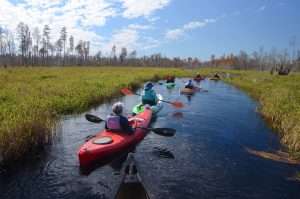Okefenokee Swamp threatened by proposed strip mine

Okefenokee Swamp, Georgia.
Atlanta
A years-long struggle by the Muskogee Creek Nation and environmentalists to preserve the Okefenokee Swamp, home of the Okefenokee National Wildlife Refuge, is ramping up its campaign to stop Alabama-based Twin Pines Minerals from strip mining the eastern edge of this unique ecosystem.
Opponents say that what is at risk is a 650-square-mile wilderness, located in southern Georgia and extending to the Florida border. The area is the largest carbon reserve in the U.S. and the source of the Suwannee and St. Marys Rivers. (garivers.org)
Home to countless unique and endangered species of birds, reptiles, mammals, fish and plant life, Okefenokee’s human history goes back thousands of years. The name comes from a shortened Muskogee Creek phrase, meaning “water shaking,” which describes how the dark, still waters moved when canoes traveled through the swamp.
The U.S. military brutally removed the Indigenous nations of the South in the 1830s to Oklahoma, at the cost of untold lives along the Trail of Tears. However, as Turner Hunt, tribal historic preservation officer for the Muskogee Creek Nation, has stated, the Okefenokee Swamp “is very much part of us as a Muskogean people.”
The Muskogee Nation has joined in the “call for a more thorough review,” in light of “the risk to the cultural and natural resources” of the Okefenokee. (Atlanta Journal-Constitution, “Report: Okefenokee Swamp among country’s ‘most endangered’ waterways,” April 18) The Muskogee Creek Nation won a legal say in management of the wildlife refuge from the Biden administration last year.
The brilliance of the stars
The hundreds of thousands of visitors who come to see this unique wilderness are mesmerized by the mirror-like quality of the waters; they reflect the trees and the sky above in the day, and at night the brilliance of the stars amazes.
It is the water loss and multiple forms of environmental degradation integral to the strip-mining process, which motivate the many forces that oppose issuing a permit to mine for titanium, a common mineral. While titanium is used in aircraft and military weaponry, it is most commonly used as a whitening agent in paint, toothpaste and other household products.
Twin Pine Minerals plans to initially dig for the mineral on some 740 acres on the Trail Ridge, an ancient inland sand dune forming a geological boundary on the eastern side of the swamp. Their plan is to dig pits 150 feet deep, remove the sand, strip out the titanium mineral particles and put the sand back, all supposedly without harming the swamp’s water table.
The U.S. Fish and Wildlife Service and independent hydrologists and environmentalists counter this argument, stating that the structural integrity of the sand dune would be destroyed and would inevitably create lower water levels and pollution impacting the wildlife and vegetation, the habitat and ecosystem.
The use of heavy equipment, the structures, noise and lights required to process tons of sand will create a disastrous impact on this rare ecosystem, opponents say. The predicted lower water levels would increase the risk of the swamp’s immense peat bogs drying out and catching fire, thus releasing centuries of stored carbon back into the atmosphere. This is a climate change disaster not to be risked.
The permitting process is in the hands of the Georgia Environmental Protection Division, which has moved the review of the Twin Pines plans along up to now, despite over 77,000 comments from the public opposing the strip mine in January and February 2023. The EPD has given no estimate on the length of time they will take to examine the many technical comments it has received.
Meanwhile the number of newspaper articles, including in the Atlanta Journal-Constitution, local organizing in the counties around the Okefenokee, and national and international attention to the dangers to its unique and special character are bringing new voices and power to the campaign to save the Okefenokee Swamp.
For more information, see garivers.org/protectokefenokee.

